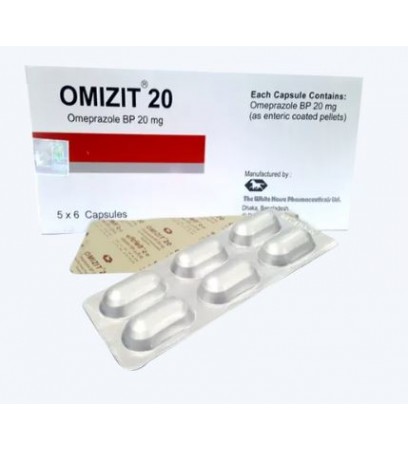Omizit 20
- Brand:NIPRO JMI Pharma Ltd.
- Product Code: Omeprazole 20mg
- Availability: In Stock
-
7.62Tk.
Indications
Omeprazole is used to treat ulcers in the stomach and duodenum.
- Duodenal and stomach ulcers caused by NSAIDs
- In patients with a history of NSAID-related duodenal and stomach ulcers, as a preventative measure
- Gastro-esophageal reflux disease (GERD) is a type of gastro-esophageal reflux
- Acid reflux disease management over time
- Dyspepsia caused by stomach acid
- Reflux esophagitis with ulcers is a serious condition.
- Acid aspiration prevention during general anesthesia
- Syndrome of Zollinger-Ellison
- Peptic ulcer caused by Helicobacter pylori.
Pharmacology
Omeprazole, a substituted benzimidazole, works as a stomach acid secretion inhibitor. It blocks the hydrogen-potassium-adenosine triphosphatase (H+/K+ ATPase) enzyme system in the gastric parietal cell, inhibiting gastric acid secretion. After oral treatment, the antisecretory effect begins within one hour, peaks within two hours, and secretion suppression lasts up to 72 hours. Secretory activity gradually recovers when the medicine is stopped, usually within 3 to 5 days.
Dosage and Administration
Oral-
Benign gastric and duodenal ulcer: 20 mg once daily for 4 weeks in duodenal ulceration, 8 weeks in gastric ulceration; in severe or recurrent cases, dose to be increased to 40 mg daily; maintenance dose for recurrent duodenal ulcer, 20 mg once daily; in prevention of relapse in duodenal ulcer, 10-20 mg daily.
NSAID-associated duodenal or gastric ulcer: 20 mg once daily for 4 weeks, continued for further 4 weeks, if not fully healed. 20 mg once daily is used as prophylaxis in patients with a history of NSAID-associated duodenal or gastric ulcers.
Gastro-esophageal reflux disease: 20 mg once daily for 4 weeks, continued for further 4-8 weeks, if not fully healed; 40 mg once daily has been given for 8 weeks in gastro-esophageal reflux disease, refractory to other treatment; maintenance dose is 20 mg once daily.
Long-term management of acid reflux disease: 10-20 mg daily.
Acid-related dyspepsia: 10-20 mg once daily for 2-4 weeks.
Prophylaxis of acid aspiration: 40 mg on the preceding evening, then 40 mg 2-6 hours before surgery.
Zollinger-Ellison syndrome: Initially 60 mg once daily; usual range 20-120 mg daily (If daily dose is more than 80 mg, 2 divided dose should be used).
Helicobacter pylori eradication regimen in peptic ulcer disease: Omeprazole is recommended at a dose of 20 mg twice daily in association with antimicrobial agents as detailed below: Amoxicillin 500 mg and Metronidazole 400 mg both three times a day for one week, or Clarithromycin 250 mg and Metronidazole 400 mg both twice a day for one week, or Amoxicillin 1 g and Clarithromycin 500 mg both twice a day for one week.
Paeditaric use in severe ulcerating reflux esophagitis (Child>1 year): If body-weight 10-20 kg, 10-20 -mg once daily for 4-12 weeks; if body-weight over 20 kg, 20-40 mg once daily for 4-12 weeks.
IV Injection-
Prophylaxis of acid aspiration: Omeprazole 40 mg to be given slowly (over a period of 5 minutes) as an intravenous injection, one hour before surgery.
Duodenal ulcer, gastric ulcer or reflux oesophagitis: In patients with duodenal ulcer, gastric ulcer or reflux oesophagitis where oral medication is inappropriate, Omeprazole IV 40 mg once daily is recommended.
Zollinger- Ellison syndrome (ZES): In patients with Zollinger-Ellison Syndrome the recommended initial dose of Omeprazole given intravenously is 60 mg daily. Higher daily doses may be required and the dose should be adjusted individually. When doses exceed 60 mg daily, the dose should be divided & given twice daily.
Direction for use of IV Injection: Omeprazole lyophilized powder and water for injection is for intravenous administration only and must not be given by any other route. Omeprazole IV injection should be given as a slow intravenous injection. The solution for IV injection is obtained by adding 10 ml water for injection to the vial containing powder. After reconstitution the injection should be given slowly over a period of at least 2 to 5 minutes at a maximum rate of 4 ml/minute. Use only freshly prepared solution. The solution should be used within 4 hours of reconstitution.
Direction for use of IV Infusion: Omeprazole IV infusion should be given as an intravenous infusion over a period of 20-30 minutes or more. The contents of one vial must be dissolved in 100 ml saline for infusion or 100 ml 5% Dextrose for infusion. The solution should be used within 12 hours when Omeprazole is dissolved in saline and within 6 hours when dissolved in 5% Dextrose. The reconstituted solution should not be mixed or co-administered in the same infusion set with any other drug.
Interaction
Omeprazole can prolong the elimination of diazepam, warfarin and phenytoin. So, reduction of warfarin or phenytoin dose may be necessary when Omeprazole is added to the treatment. There is no evidence of an interaction of Omeprazole with theophylline, propranolol or antacids.
Contraindications
Omeprazole is contraindicated in patients with known hypersensitivity to any of the components of the formulation.
Side effects
Omeprazole is generally well tolerated. Nausea, abdominal colic, paresthesia, dizziness and headache have been stated to be generally mild and transient and not requiring a reduction in dosage.
Pregnancy & Lactation
Omeprazole is classified as a pregnancy category C by the US Food and Drug Administration. However, three prospective epidemiological studies show that Omeprazole has no negative impact on pregnancy or the health of the fetus/newborn kid. There is no information on Omeprazole's transit into breast milk or its effects on the newborn. If the usage of Omeprazole is regarded necessary, breast-feeding should be terminated.
Precautions & Warnings
When gastric ulcer is suspected, the possibility of gastric malignancy should be excluded before treatment with Omeprazole is instituted, as treatment may alleviate the symptoms and delay diagnosis.
Therapeutic Class
Proton Pump Inhibitor
Storage Conditions
Keep in a dry place away from light and heat. Keep out of the reach of children.
Tags: Omizit 20

